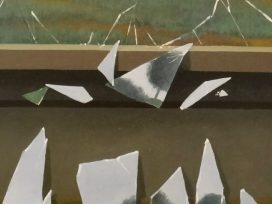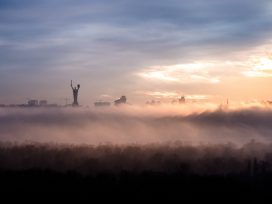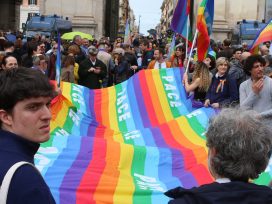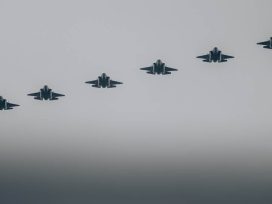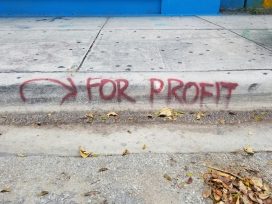His phone had almost given up the ghost. It’s just a simple phone, the main thing is that people can call him on it. And call him they do, continuously. Asking him about some projectors. Sometimes about cookies. About options for staying somewhere overnight. “Hmm, I now have to find accommodation somewhere for this girl. In a flat, where there is at least warm water.” In Sloviansk, a city of 100,000 souls in eastern Ukraine, sometimes there is no warm water. Sometimes there is no light either. Or the heating doesn’t work. That’s everyday life for Yevgeny Skripnik. “What does one expect in a city that hardly anyone was interested in before the war, and which the war hasn’t exactly made more accommodating?”, he asks almost casually, having tucked his telephone inside his jacket. However, Yevgeny Skripnik wants people to be interested in this city. Because he does not want it to go down in history as a mere synonym for the fierce fighting between pro-Russian separatists and the Ukrainian army in summer 2014. Two months of artillery fire, street blocks, supply bottlenecks. Then there were the dead, the wounded and those who fled.
Hardly anyone here wants to remember this period. 100 kilometres away, the war is not over. Indeed, this war in the middle of Europe has been almost completely forgotten. Some in Sloviansk even comment that it’s good the war exists. Not because of the suffering, the lost sons, fathers, men, the wounded children, destroyed houses. God forbid! “But we’ve woken up at last, we’ve grasped at long last, that we are responsible for our country. For our stairwells, our back yards, our cities.” This is the way some residents talk to us in Sloviansk, even if many other people still await someone to come along and make everything good again. The government in Kyiv? In Moscow? The separatists? It is the old Soviet comfort, a notion that seems to have possessed these people.
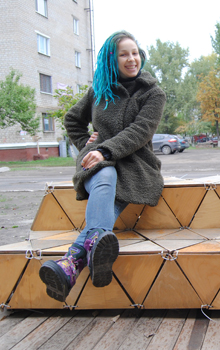
Photo: Inna Hartwich
Yevgeny Skripnik doesn’t want to wait. Neither does Yana Pomelnikova. And nor does Nastya, who calls herself “Sliwa”, “the plum”, because she has blue dreadlocks and is therefore something of a sensation in a town like Sloviansk. They are 19, 29 and 23 years old. They want to become computer scientists or have studied fine art. Above all though, they have learnt in the past few months to apply to international organizations for grants, to mount crowdfunding campaigns in order to receive money with which to “change people’s consciousness”.
Along with seven other young people, they want to get something going in their city. Here, where blue-white posters line the main streets, celebrating nothing other than “two years of peace”, while the burnt-out windows in some houses provide a reminder of just how close war still is. “Tepliza”, which means “greenhouse”, is what they call this space where the city’s youth are supposed to gather. Because, “in a greenhouse, the conditions are tailored to vegetables growing ripe. Here in the Tepliza, a new spirit shall circulate”, says “Sliwa”. In the former branch of a bank at the periphery of the city centre, they’ve painted the wall green and purple and written twelve rules next to a door: Be active! Watch your choice of words! Wash up your cup yourself! Things like that. A kind of youth club has emerged, the city’s first and only. “I’ve met people here from western Ukraine, had conversations with Poles and Lithuanians, gotten to know other points of view, grown more tolerant”, says the 16-year old Katya, who has continued to visit Tepliza after school, ever since the project began.
Organize English courses, recite poetry, invite musicians, talk things over with Danes and Americans
The active young people of Sloviansk want to give the wasteland in which they live a colourful face. “Just to do something here”, they say. Organize English courses, recite poetry, invite musicians, talk things over with Danes and Americans. Clear the undergrowth from a park once in a while, or paint a transmission substation and old cinema screen. Sometimes though, they make sure that everyone who wants to come to their city has warm water. Light. Working heating. This is all part of their project, entitled “Your Local Area”: receiving other Ukrainians in Sloviansk and showing them around town, telling them about its history. “Getting connected”, they call it. Combatting “the trauma of potentially losing one’s home”. This is how Alexei Ovtschinnikov expresses it, as the initiator of the project. More than a year ago, he founded Tepliza. Similar buildings in Ukraine provided models for the project. In the interim, the dancer who owned the dance school had left the building to Yevgeny, Sliwa and the others, and moved on to other projects dealing with the social commitment of city residents. He had wanted to create a foundation upon which to prompt people to consciously start to think. “It’s values that are at stake. European values, right here too, that we sometimes lose sight of in the darkness. That’s what thousands of people went to the Maidan in Kyiv for.”
The Maidan, this square of independence in the centre of Kyiv. In 2004, tens of thousands had already gathered here to demonstrate against instances of electoral fraud: the Orange Revolution only brought limited change to the country. In 2013, people stood here once again. They wanted to join Europe. Viktor Yanukovych, who was president at the time, did not. The state responded harshly, shots were fired. Since then, the country staggers on, in search of itself. Who are we, who do we want to be, how do we want to live, what sort of history, what sort of memory do we wish to maintain? The Maidan has changed everything in Ukraine. It constitutes a caesura that is reflected in every conversation. “Before the Maidan” people say, and “after the Maidan”.
It was the Maidan that first made projects like Tepliza possible. Or made projects like the post-industrial culture project ISOLYATSIA, (“Isolation”) from Donetsk homeless. Armed men from the self-declared “Donetsk People’s Republic” overran the cultural centre two years ago. Since then, ISOLYATSIA has attempted to find its feet in Kyiv’s cultural scene. “We have become nomads and must reorient ourselves. No simple task”, says Olexandr Vinogradov of ISOLYATSIA.
It was the Maidan too that allowed writers, musicians and directors to go to the front and left some broken and resigned to everyday life. It was the Maidan that turned art in the country into a “social movement”, as the Kyiv cultural manager Olha Hontschar says. “It is annoying, how the government constantly says that we first have to win the war and then concern ourselves with everything else afterwards. No, we have to care for people now, give them a sense of purpose, sit down and ask: What will be left here in the end?”, she says in Ukraine House in central Kyiv, just 700 kilometres away from Sloviansk. The Maidan made art political. “For every statement about Ukraine is political today”, says the Kyiv journalist Vira Baldyniuk. The modern museum that belongs to the oligarch Victor Pinchuk in Kyiv, which has been a hip contemporary art venue for years, shows exhibitions such as “Guilt”. Young Ukrainian artists deal with their country’s contemporary history. Here stands a flag made out of a shot-up delivery van, over there is a picture with a dark blotch in the middle that is supposed to remind the viewer that only an incomplete sample of reality is ever possible. It is a subdued work that leaves one feeling apprehensive.
Since the Maidan, Ukrainian folk art has also become increasingly popular. Even in Sloviansk, projects like Café Prostokava by Julia Goryun are possible. There is not only coffee here, they also sell various handmade and specially designed items. The concept is financed in part by the United Nations. Further, documentary film and documentary photography first emerged with Maidan. There is currently a boom in contemporary art too. “Previously, Ukrainians scarcely had any idea of what’s required in order to reflect upon this art or to deal with the production of public space. Now there is everything”, says the journalist Baldyniuk.
“Everything” is a word often used in connection with the Maidan and its consequences. That is not to the liking of everyone. “When you say you come from Ukraine, everyone expects your art to express something about Ukrainian politics”, says the street artist Apl315 from Odessa. It’s no longer the done thing to be unpolitical. Nonetheless, he travels to eastern Ukraine and participates in projects in cities close to the front. “Many here are not ready for street art, first you have to educate people. There’s a lot in Kyiv. But elsewhere?”
In Sloviansk, there is Tepliza, and much hope in the faces of its young operators.
